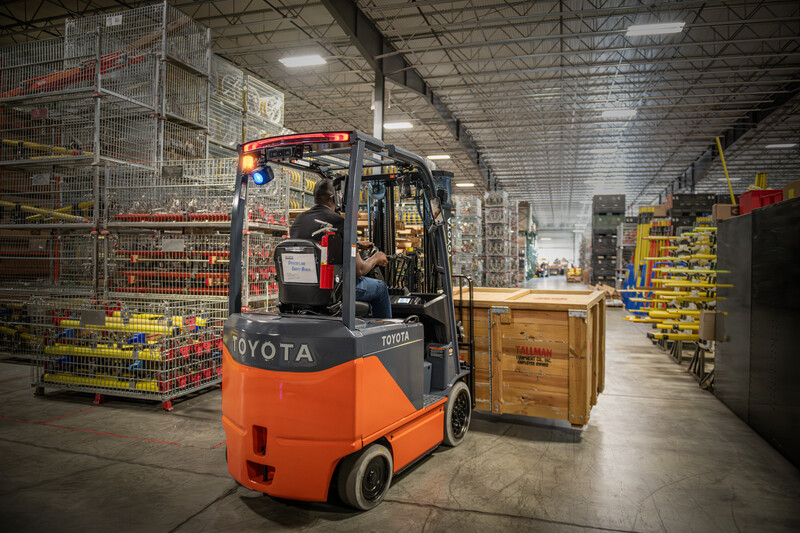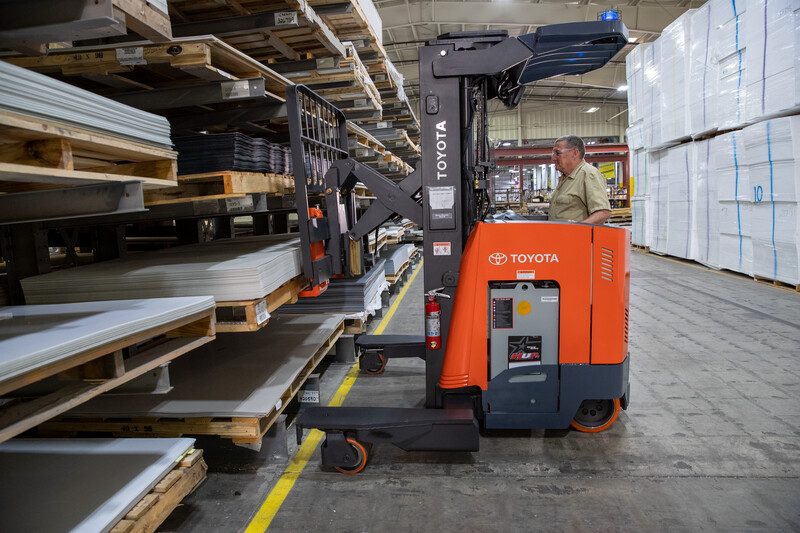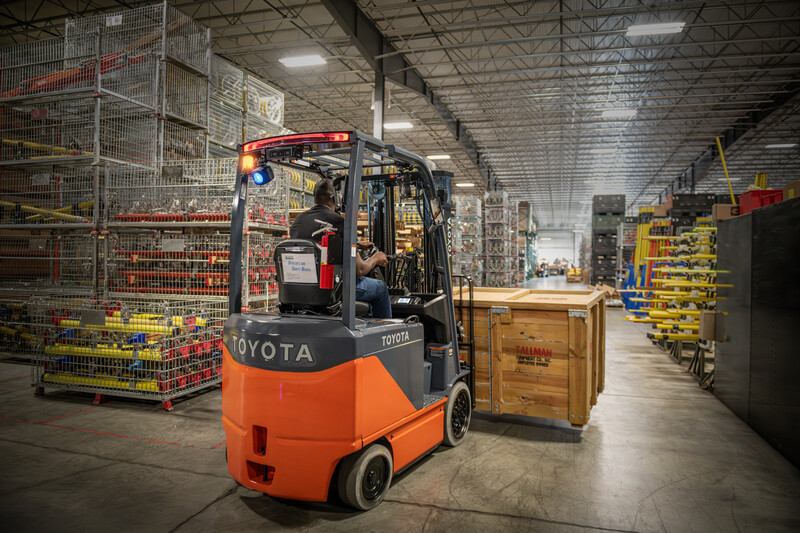In today’s fast-paced, competitive business environment, warehouse efficiency is critical for success. From reducing operational costs to increasing productivity, every aspect of warehouse management matters. One of the most effective ways businesses are boosting their efficiency is by incorporating electric forklifts into their material handling fleets. Among the leaders in this shift is Toyota, renowned for its innovative solutions in forklift design. Toyota’s electric forklifts not only contribute to a greener environment but also play a key role in enhancing warehouse operations. Let’s explore how these high-performance machines can transform your warehouse efficiency.
1. Lower Operating Costs with Electric Power
One of the most immediate benefits of switching to Toyota electric forklifts is the significant reduction in operating costs. Traditional internal combustion (IC) forklifts rely on gas or diesel, which can incur high fuel costs and require regular maintenance. In contrast, Toyota’s electric forklifts run on batteries, which are more cost-effective and require less maintenance overall.
With electric forklifts, businesses benefit from:
-
Lower fuel expenses: Electricity is often cheaper than gas or diesel, especially in areas with high fuel costs.
-
Reduced maintenance: Electric forklifts have fewer moving parts and don’t require regular engine maintenance, oil changes, or exhaust system repairs, leading to fewer service calls and longer uptime.
This reduction in operational costs directly contributes to more efficient warehouse operations and improves a company’s bottom line.
2. Enhanced Productivity with Faster Operations
In a warehouse, every second counts. Toyota’s electric forklifts are designed for maximum productivity, allowing businesses to move goods more quickly and efficiently. These forklifts feature smooth acceleration, precise control, and greater maneuverability compared to their gas-powered counterparts.
Some key features include:
-
Faster lifting and travel speeds: Toyota electric forklifts can handle loads quickly and efficiently, reducing the time it takes to complete each task.
-
Precision and control: With advanced technology, Toyota’s electric forklifts offer better handling, which is essential in tight spaces and crowded warehouse environments.
These enhancements allow operators to complete tasks more quickly, increasing the overall throughput of goods in the warehouse.
3. Longer Shifts and Reduced Downtime
Toyota electric forklifts are built for long-lasting performance, with the ability to work extended hours without significant downtime. With the option to swap out batteries in a matter of minutes, warehouses can keep their electric forklifts running continuously throughout a shift, ensuring minimal downtime.
The lithium-ion battery technology used in many Toyota electric forklifts offers:
-
Quick recharging: Lithium-ion batteries charge faster than traditional lead-acid batteries, meaning forklifts can be back in action in less time.
-
Longer battery life: These batteries have a longer lifespan, reducing the need for frequent replacements and ensuring more reliable performance over time.
As a result, warehouse operators can rely on Toyota’s electric forklifts to keep operations running smoothly throughout the day and night, minimizing interruptions to workflows.
4. Improved Safety and Ergonomics
Safety and comfort go hand-in-hand when it comes to warehouse efficiency. Toyota has integrated a range of safety features into their electric forklifts to ensure operators stay safe while working efficiently.
For example:
-
Enhanced stability: Toyota electric forklifts are designed with advanced stability control systems to help prevent tip-overs and improve overall safety when handling loads.
-
Ergonomic design: The design of Toyota electric forklifts prioritizes operator comfort. Features like adjustable seating, easy-to-use controls, and better visibility contribute to reducing operator fatigue and enhancing performance.
-
Safety sensors and features: Toyota forklifts are equipped with safety systems such as sensors that can detect obstacles or other equipment, alerting the operator and preventing potential accidents.
The result is a safer working environment where employees can operate the forklifts with confidence, leading to fewer accidents and less downtime due to injury.
5. Environmentally Friendly Operations
With growing environmental concerns, more and more businesses are looking for sustainable ways to run their operations. Toyota’s electric forklifts help reduce a warehouse’s carbon footprint and improve environmental performance. Unlike gas-powered forklifts, which produce emissions and require fuel delivery, electric forklifts run cleanly on batteries.
Benefits include:
-
Zero emissions: Toyota electric forklifts produce no exhaust fumes, making them ideal for indoor operations, especially in enclosed warehouse spaces.
-
Quieter operation: These forklifts operate much more quietly than their internal combustion counterparts, reducing noise pollution in the workplace.
-
Lower energy consumption: Toyota’s energy-efficient electric forklifts consume less power, contributing to lower overall energy usage in the warehouse.
By adopting Toyota’s electric forklifts, warehouses can achieve greener operations, which not only contribute to environmental goals but can also help meet sustainability standards and reduce energy costs.
6. Integration of Advanced Technology
Toyota continuously pushes the envelope on technology in the material handling industry. Their electric forklifts come equipped with advanced features that boost efficiency. Some of these innovations include:
-
Telematics and fleet management software: Toyota offers integrated telematics systems that provide real-time data on forklift performance, maintenance needs, and operator behavior. This data can be used to optimize forklift usage, plan preventative maintenance, and improve overall fleet management.
-
Smart controls: Features like regenerative braking and automated load handling help reduce energy consumption and improve overall operation efficiency.
This cutting-edge technology not only makes Toyota electric forklifts more efficient but also gives warehouse managers more control over their fleets, allowing them to make data-driven decisions.
7. Flexible Options for Different Warehouse Needs
Toyota offers a wide range of electric forklift models, each designed to suit specific material handling needs. Whether you’re dealing with narrow aisles, heavy loads, or specialized tasks, there’s a Toyota electric forklift model designed to meet the unique requirements of your warehouse. This flexibility ensures that your operations are as efficient as possible, regardless of the challenges your warehouse faces.
Conclusion
Toyota’s electric forklifts are more than just a green alternative to traditional material handling equipment—they’re a game-changer for warehouse efficiency. With lower operating costs, faster operation, enhanced safety, and a commitment to sustainability, these forklifts provide businesses with the tools they need to thrive in an increasingly competitive market. By adopting Toyota electric forklifts, warehouses can streamline their operations, reduce downtime, and contribute to a cleaner environment—all while improving their bottom line.
If you’re looking to boost your warehouse’s efficiency, it’s time to consider Toyota’s electric forklifts. They represent the future of material handling, and the future is already here.








